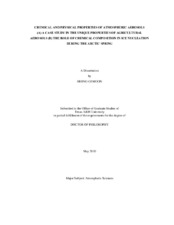| dc.description.abstract | This study focuses on the analysis of atmospheric particles sampled from two different field campaigns: the field study at a cattle feeding facility in the summer from 2005 to 2008 and the Indirect and Semi-Direct Aerosol Campaign (ISDAC) in 2008.
A ground site field study at a representative large cattle feeding facility in the Texas Panhandle was conducted to characterize the particle size distributions, hygroscopicity, and chemical composition of agricultural aerosols. Here, a first comprehensive dataset is reported for these physical and chemical properties of agricultural aerosols appropriate for use in a site-specific emission inventory. The emission rate and transport of the aerosols are also discussed. In addition, mixing ratios of total and gaseous ammonia were measured at the same field in 2007 and 2008. Measurements such as these provide a means to determine whether the fugitive dust emitted from a typical large feedlot represents a health concern for employees of the feeding operation and the nearby community.
Detailed chemical composition of aircraft-sampled particles collected during ISDAC was studied. Filter samples were collected under a variety of conditions in and out of mixed phase and ice clouds in the Arctic. Specifically, particles were sampled from a mixed-phase cloud during a period of observed high concentrations of ice nuclei (IN), a biomass plume, and under relatively clean ambient conditions. Composition of particles was studied on a particle-by-particle basis using several microspectroscopy techniques. Based on the elemental composition analysis, more magnesium was found in Arctic cloud residues relative to ambient air. Likewise, based on the carbon speciation analysis, high IN samples contained coated inorganics, carbonate, and black or brown carbon particles. In the samples collected during a flight through a biomass burning plume, water-soluble organic carbon was the dominant overall composition. Due to their hygroscopic nature, these organics may preferably act as cloud condensation nuclei (CCN) rather than IN. Other ambient samples contained relatively higher fractions of organic and inorganic mixtures and less purely water-soluble organics than found in the biomass particles. The most likely source of inorganics would be sea salt. When present, sea salt may further enhance ice nucleation. | en |


